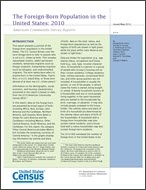The Foreign-Born Population in the United States: 2010
The Foreign-Born Population in the United States: 2010
Introduction
This report presents a portrait of the foreign-born population in the United States. The U.S. Census Bureau uses the term foreign born to refer to anyone who is not a U.S. citizen at birth. This includes naturalized citizens, lawful permanent residents, temporary migrants (such as foreign students), humanitarian migrants (such as refugees), and undocumented migrants. The term native born refers to anyone born in the United States, Puerto Rico, or a U.S. Island Area, or those born abroad of at least one U.S. citizen parent.1
Information on the demographic, social, economic, and housing characteristics presented in this report is based on data from the 2010 American Community Survey (ACS).2
In this report, data on the foreign born are presented by broad region of birth, including Africa, Asia, Europe, Latin America and the Caribbean, Northern America, and Oceania. More detail is shown for Latin America and the Caribbean—including Mexico, Other Central America, South America, and the Caribbean. For this report, the category Other Central America excludes Mexico but includes the remaining countries of Central America.3 In the graphs displaying information by nativity and place of birth, data on the total, native, and foreign-born populations as well as the regions of birth are shown in light green, while the areas within Latin America are shown in light blue.4
Data are shown for population (e.g., age, marital status, occupation) and household (e.g., size, type, income) characteristics. A household is a person or a group of people who occupy a housing unit as their current residence. College residence halls, military barracks, correctional facilities, and other group quarters are not included. A householder is usually the person, or one of the people, in whose name the home is owned, being bought, or rented. A family household consists of a householder and one or more people living together in the same household who are related to the householder by birth, marriage, or adoption. It may also include people unrelated to the householder. The nativity status and place of birth of a household are determined by the nativity status and place of birth of the householder. A household with a foreign-born householder may also contain native residents, and a household with a native householder may also contain foreign-born residents.
The 2010 ACS estimated the number of foreign born in the United States to be nearly 40 million, or 13 percent of the total population (Table 1).5
The foreign-born population from Latin America was the largest region-of-birth group, accounting for over half (53 percent) of all foreign born (Table 2). By comparison, 28 percent of the foreign born were born in Asia, 12 percent in Europe, 4 percent in Africa, 2 percent in Northern America, and less than 1 percent in Oceania.6 Among the 21.2 million foreign born from Latin America, 11.7 million, or over half (55 percent), were born in Mexico. Of the total foreign-born population, 29 percent were born in Mexico.
__________
1 The terms native and native born are used interchangeably in this report. U.S. Island Areas include Guam, American Samoa, the U.S. Virgin Islands, and the Commonwealth of the Northern Mariana Islands.
2 Additional information about the ACS is available on the Census Bureau’s Web site at www.census.gov/acs/www/.
3 Other Central America includes the countries of Belize, Costa Rica, El Salvador, Guatemala, Honduras, Nicaragua, and Panama.
4 The term Latin America and the Caribbean includes countries in Central and South America and the Caribbean. Throughout the remainder of this report, the term Latin America is used to refer to all of these areas. A complete list of the countries included in the regions and subregions is available on the Census Bureau’s Web site at www.census.gov/programs-surveys/acs/technical-documentation/code-lists.2010.html.
5 This report discusses data about residents of the United States, including the 50 states and the District of Columbia; it does not include data about residents of Puerto Rico. Population totals shown in this report are as of July 1, 2010.
6 The majority of the foreign born from Northern America were from Canada (99 percent). About two-thirds of the foreign born from Oceania were from Australia and New Zealand (48 percent) and Fiji (18 percent).
Visualizations
Others in Series
Publication
Publication
Publication




